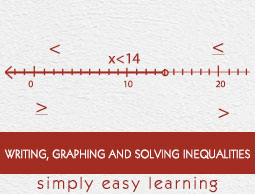
- Writing, Graphing and Solving Inequalities
- Home
- Translating a Sentence by Using an Inequality Symbol
- Translating a Sentence into a One-Step Inequality
- Introduction to Identifying Solutions to an Inequality
- Writing an Inequality for a Real-World Situation
- Graphing a Linear Inequality on the Number Line
- Writing an Inequality Given a Graph on the Number Line
- Identifying Solutions to a One-Step Linear Inequality
- Additive Property of Inequality with Whole Numbers
- Multiplicative Property of Inequality with Whole Numbers
- Solving a Two-Step Linear Inequality with Whole Numbers
- Solving a Word Problem Using a One-Step Linear Inequality
Multiplicative Property of Inequality with Whole Numbers
Introduction
The Multiplicative property of Inequality states that, for any three numbers a, b, and c
If a > b, then ac > bc, if c > 0
If a > b, then ac < bc, if c < 0
A number line can help model what is going on when c > 0, as well as why the inequality sign flips when c < 0.
When we multiply, or divide both sides of an inequality by a negative number we change less than into greater than and vice versa or flip the inequality sign.
Example 1
Solve the following using multiplicative property of inequality −
$\frac{15}{x}$ > 5
Solution
Step 1:
Given $\frac{15}{x}$ > 5;
Cross multiplying 15 > 5x
Using multiplicative property of inequality, we divide both sides by 5
15/5 < 5x/5; 3 < x
Step 2:
So, the solution for the inequality is x > 3
Example 2
Solve the following using multiplicative property of inequality −
11 ≤ 154 /q
Solution
Step 1:
Given 11 ≤ $\frac{154}{q}$
Cross multiplying 11q ≤ 154
Using multiplicative property of inequality, we divide both sides by 11
$\frac{11q}{11}$ ≤ $\frac{154}{11}$; q ≤ 14
Step 2:
So, the solution for the inequality is q ≤ 14